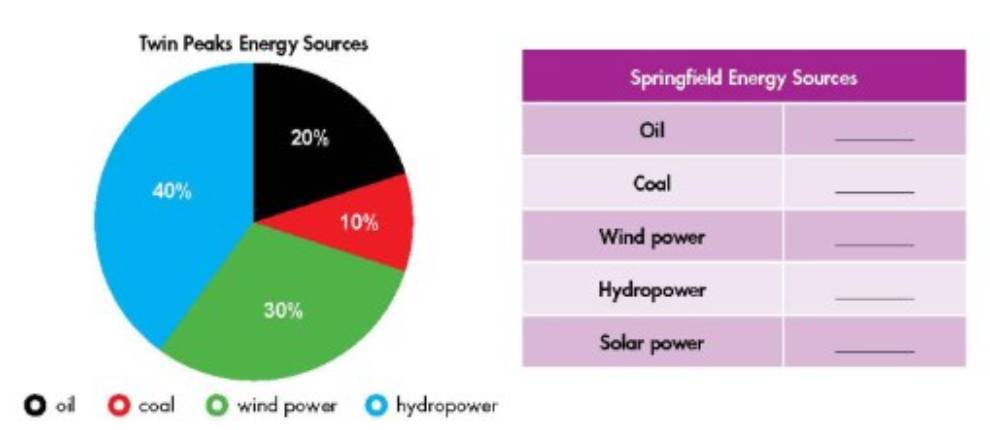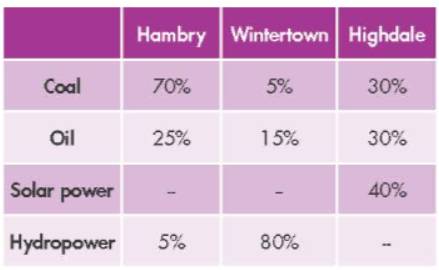Lesson 1
Các câu hỏi tương tự
a. Stress the first syllable for numbers which are multiples of ten.
(Nhấn mạnh âm tiết đầu tiên cho các số tròn chục.)
d. In pairs: Compare more information from the table. Use the prompts.
(Theo cặp: So sánh thông tin từ bảng và sử dụng gợi ý.)
Wintertowwn/ coal/ Hambry
Highdale/ hydropower/ Wintertown
c. Listen and cross out the word that doesnt follow the note in a.(Nghe và loại bỏ từ mà không tuân theo ghi chú ở phần a.) forty sixty
Đọc tiếp
c. Listen and cross out the word that doesn't follow the note in "a."
(Nghe và loại bỏ từ mà không tuân theo ghi chú ở phần a.)
forty
sixty
a. Youre an energy expert interested in how two different cities use different kinds of energy. In pairs: Student B, it p.123 File 11. Student A, ask about Springfield and complete the table. Swap roles. Answer questions about Twin Peaks. (Bạn là một chuyên gia quan tâm về việc hai thành phố khác nhau sử dụng những loại năng lượng khác nhau như thế nào. Theo cặp: Học sinh B, file 11 trang 123. Học sinh A, hỏi về Springfield và hoàn thành bảng. Hoán đổi vai trò. Trả lời câu hỏi về Twin Peaks.)
Đọc tiếp
a. You're an energy expert interested in how two different cities use different kinds of energy.
In pairs: Student B, it p.123 File 11. Student A, ask about Springfield and complete the table. Swap roles. Answer questions about Twin Peaks.
(Bạn là một chuyên gia quan tâm về việc hai thành phố khác nhau sử dụng những loại năng lượng khác nhau như thế nào.
Theo cặp: Học sinh B, file 11 trang 123. Học sinh A, hỏi về Springfield và hoàn thành bảng. Hoán đổi vai trò. Trả lời câu hỏi về Twin Peaks.)

c. Look at the table and write the sentences.(Nhìn bảng và viết câu.)1. Hambry/oil/HighdaleHambry gets less energy from oil than Highdale.2. Highdale/coal/Hambry3. Highdale/solar power/Wintertown4. Hambry/coal/Highdale5. Wintertown/hydropower/Hambry6. Wintertown/Hambry/oil/Highdale
Đọc tiếp
c. Look at the table and write the sentences.
(Nhìn bảng và viết câu.)
1. Hambry/oil/Highdale
Hambry gets less energy from oil than Highdale.
2. Highdale/coal/Hambry
3. Highdale/solar power/Wintertown
4. Hambry/coal/Highdale
5. Wintertown/hydropower/Hambry
6. Wintertown/Hambry/oil/Highdale

a. Listen to Emma and James talking to experts at an energy convention. What do they want to learn about?(Nghe về Emma và James nói chuyện với chuyên gia ở một hội nghị năng lượng. Họ học về điều gì?) 1. different energy sources ( các nguồn năng lượng khác nhau)2. renewable energy sources only (chỉ những năng lượng tái tạo)
Đọc tiếp
a. Listen to Emma and James talking to experts at an energy convention. What do they want to learn about?
(Nghe về Emma và James nói chuyện với chuyên gia ở một hội nghị năng lượng. Họ học về điều gì?)
1. different energy sources ( các nguồn năng lượng khác nhau)
2. renewable energy sources only (chỉ những năng lượng tái tạo)
b. Compare the energy sources for Twin Peaks and Springfield. Which city uses more renewable energy?
(So sánh nguồn năng lượng giữa Twin Peaks và Springfield. Thành phố nào sử dụng nhiều năng lượng tái tạo hơn?)
a. Fill in the table. Listen and repeat.(Điền vào bảng. Nghe và lặp lại.) Renewable energy is green energy. It is clean and good for the environment.(Năng lượng có thể thay thế là năng lượng xanh. Nó sạch và tốt cho môi trường.)Non-renewable energy sources can cause pollution.(Năng lượng không thể thay thế có thể gây ô nhiễm.)
Đọc tiếp
a. Fill in the table. Listen and repeat.
(Điền vào bảng. Nghe và lặp lại.)

Renewable energy is "green" energy. It is clean and good for the environment.
(Năng lượng có thể thay thế là năng lượng xanh. Nó sạch và tốt cho môi trường.)
Non-renewable energy sources can cause pollution.
(Năng lượng không thể thay thế có thể gây ô nhiễm.)
c. In pairs: What sources of energy does your country use? Do you think it uses more non-renewable or renewable energy?(Theo cặp: Nguồn năng lượng nào đất nước bạn sử dụng? Bận nghĩ nó sử dụng nhiều năng lượng không tái tạo hay năng lượng tái tạo?)Conversation Skill (Kỹ năng hội thoại)Asking for clarification (Hỏi về sự rõ ràng)To ask someone to repeat what they just said, say: (Để yêu cầu ai đó lặp lại những gì họ đã nói:)Did you say (12%) or (20%)? (Có phải bạn nói là (12%) hay (20%)?)Listen a...
Đọc tiếp
c. In pairs: What sources of energy does your country use? Do you think it uses more non-renewable or renewable energy?
(Theo cặp: Nguồn năng lượng nào đất nước bạn sử dụng? Bận nghĩ nó sử dụng nhiều năng lượng không tái tạo hay năng lượng tái tạo?)
Conversation Skill (Kỹ năng hội thoại) Asking for clarification (Hỏi về sự rõ ràng) To ask someone to repeat what they just said, say: (Để yêu cầu ai đó lặp lại những gì họ đã nói:) Did you say (12%) or (20%)? (Có phải bạn nói là (12%) hay (20%)?) Listen and repeat. (Nghe và lặp lại.) |
Ask and answer. Then, compare energy sources in Bigton and Greenville. Swap roles and repeat.(Hỏi và trả lời. Sau đó, so sánh các nguồn năng lượng ở Bigton và Greenville. Hoán đổi vai trò và lặp lại.)How much energy does Bigton get from solar power? (Bigton nhận được bao nhiêu năng lượng từ năng lượng mặt trời?)It gets three percent from solar power. What about Greenville?(Nó nhận được 3% từ năng lượng mặt trời. Còn Greenville thì sao?)Greenville gets one per cent from solar power.(Greenville nh...
Đọc tiếp
Ask and answer. Then, compare energy sources in Bigton and Greenville. Swap roles and repeat.
(Hỏi và trả lời. Sau đó, so sánh các nguồn năng lượng ở Bigton và Greenville. Hoán đổi vai trò và lặp lại.)

How much energy does Bigton get from solar power?
(Bigton nhận được bao nhiêu năng lượng từ năng lượng mặt trời?)
It gets three percent from solar power. What about Greenville?
(Nó nhận được 3% từ năng lượng mặt trời. Còn Greenville thì sao?)
Greenville gets one per cent from solar power.
(Greenville nhận được 1% từ năng lượng mặt trời.)
Greenville gets less energy from solar power than Bigton.
(Greenville nhận được ít năng lượng hơn từ năng lượng mặt trời so với Bigton.)

